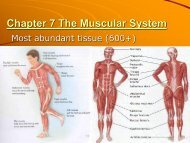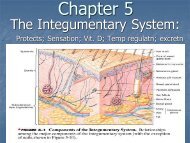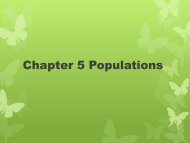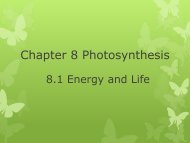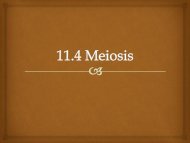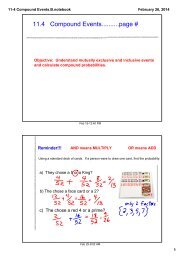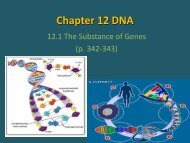Chapter 10 Cell Growth and Division.pdf
Chapter 10 Cell Growth and Division.pdf
Chapter 10 Cell Growth and Division.pdf
You also want an ePaper? Increase the reach of your titles
YUMPU automatically turns print PDFs into web optimized ePapers that Google loves.
<strong>Chapter</strong> <strong>10</strong>
<strong>10</strong>.1 <strong>Cell</strong> <strong>Growth</strong><br />
A. Limits to cell Size<br />
1. DNA Overload: with cell growth, no new DNA made<br />
‣Greater dem<strong>and</strong> <strong>Cell</strong> NOT able to provide<br />
2. Exchanging Materials<br />
‣Rate of exchange depends on membrane surface area(SA)<br />
‣Rate of food & O 2 used/waste produce depends on cell<br />
volume (V)
3. Ratio of SA to V<br />
‣Ratio = SA (l x w x # of sides)<br />
V (l x w x h)<br />
‣V INCREASES faster than SA<br />
PROBLEM: lower ratio = cell works harder to get<br />
materials in <strong>and</strong> waste out (traffic jam)
4. <strong>Cell</strong> <strong>Division</strong><br />
‣Before <strong>Division</strong>: cell replicates DNA<br />
‣<strong>Cell</strong> divides into 2 identical daughter cells<br />
‣<strong>Division</strong> reduces cell V = increase SA/V ratio
B. <strong>Cell</strong> division & reproduction<br />
1. Asexual Reproduction<br />
‣ Genetically identical offspring from single parent<br />
‣ Reproduction for single-celled organisms<br />
‣ Method of growth/budding in multicelled organisms
2. Sexual Reproduction<br />
‣ Offspring inherits genetic material from each parent<br />
‣ Offspring formed by fusion of special reproductive<br />
cells
c. Comparing asexual/Sexual Reprod.<br />
Asexual<br />
Sexual<br />
Genetically identical offspring<br />
Genetically diverse offspring<br />
Quick reprod. w/large # of offspring<br />
Diversity advantageous w/envirn.<br />
change
<strong>10</strong>.2 The process of <strong>Cell</strong> <strong>Division</strong><br />
A. Chromosomes:<br />
◦ Bundled packages of DNA carrying cells genetic info
B. Prokaryotic chromosomes<br />
‣ Single circular DNA str<strong>and</strong> in cytoplasm<br />
1. <strong>Cell</strong> Cycle: rapid growth/DNA replication/division<br />
‣<strong>Division</strong> regulated by cell size<br />
‣Binary fission: cell pinches in (two genetically<br />
identical cells)
C. Eukaryotic Chromosomes:<br />
‣ More DNA w/multiple chromosomes (humans=46)<br />
‣ Chromatin: material making up chromosomes (DNA<br />
coiled around proteins called histones)<br />
‣ Nucleosomes: beadlike structure of chromosomes<br />
‣ Condense & become visible during division<br />
‣ Chromosomes ensure precise division of DNA
1. Eukaryote <strong>Cell</strong> Cycle<br />
◦ Stages cell goes thru (grows copies DNA divides)<br />
◦ Includes Interphase (G 1 , S, G 2 ), Mitosis & Cytokinesis
a) Interphase— “in-between”-majority of cell’s life<br />
1) G 1 (Gap 1 ) - cell growth size w/protein/organelles<br />
2) S (Synthesis) - chromosomes replicate, copying DNA<br />
3) G 2 - shortest phase, prep for division
) Mitosis:division of nucleus (quick process)<br />
1) Prophase—P is for poles, packing, & pieces<br />
‣Poles: centrioles to poles-form spindle fibers to sep<br />
chromosomes<br />
‣Packing: DNA condenses-duplicated sister chromatids<br />
attached at centromere become visible<br />
‣Pieces: Nuclear envelope breaks up
2) Metaphase—M for “middle”<br />
‣Centromeres line up across center of cell<br />
‣Spindle fibers connect to dubl chrom centromere
3) Anaphase—A is for apart<br />
‣Centromeres split sister chromatids become<br />
daughter chromosomes
4) Telophase—T is for tidy up<br />
‣Reverses everything in prophase<br />
‣Nuclear Envelope reappears<br />
‣DNA relaxes<br />
‣Spindle breaks apart
c) Cytokinesis: division of cytoplasm<br />
‣Occurs during telophase<br />
‣Plants: cell plate forms between nuclei dividing cells<br />
‣Animals: membrane pinches in until cytoplasm &<br />
organelles equally divided
Mitosis Visual Summary
<strong>10</strong>.3 Regulating <strong>Cell</strong> Cycle<br />
A. Controls on <strong>Cell</strong> <strong>Division</strong><br />
‣Skin, blood, bones cells divide thru out life<br />
‣W/injury: cells divide until contact other cells<br />
1. Cyclins: Proteins that regulating cell cycle<br />
‣Internal regulatory proteins: respond inside events<br />
(wastes build-up; chromo replctn before mitosis)<br />
‣External regulatory proteins: respond outside events<br />
• Ex: <strong>Growth</strong> factors (embryonic dev, wound healing)<br />
‣Apoptosis: programmed cell death (shapes bone,<br />
fingers)
B. Cancer: uncontrolled cell growth<br />
‣<strong>Division</strong> not regulated by cyclins<br />
‣Tumor – mass of cells (benign or malignant-spread)<br />
‣Block nerve connectn, steal nutrients, stop orgn functning<br />
‣Most cancers have defect in gene p53<br />
‣Halts cell cycle till all chromos replicated<br />
‣Damaged p53 cause cells to lose info for normal controls<br />
‣Treatmnt: removal (skin cancer), radiatn, chemothrpy
<strong>10</strong>.4 <strong>Cell</strong> Differentiation<br />
A. Stem cells<br />
‣ Unspecialized cells which become differentiated cells<br />
1. Totipotent stem cells: can develop into any cell type<br />
‣ Fertilized egg/also cells of first few divisions<br />
2. Blastocyst: early hollow ball of cells<br />
‣ Pluripotent cells (inner cells): can become most<br />
cell types (can not become placenta)<br />
‣ Embryonic Stem <strong>Cell</strong>s: are pluripotent-can become<br />
all cells of body
3. Adult Stem <strong>Cell</strong>s<br />
‣ Body contains pool of stem cells (skin, blood)<br />
‣ Are multipotent (more limited)<br />
‣ <strong>Cell</strong>s of an organ/tissue typically become that<br />
organ/tissue




